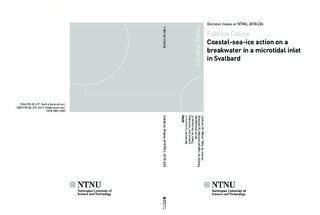| dc.description.abstract | In order to open a coal mine in Ispallen, a prospect of the company Store Norske, it will necessary to transport the coal across a tidal inlet, Sveasundet, in Svea, Svalbard. In anticipation of this challenge, Store Norske partly funded a PhD position at UNIS to study the action of the ice on a possible causeway across the inlet and, more generally, to better understand the action of sea ice on coastal structures.
I designed and supervised the construction of a 50-m-long, 8-m-high and 25-m-wide breakwater in this microtidal environment—2.0 m maximum tidal range—where the seaice period lasts between 4 and 6 months.
At the tip of the breakwater I installed a cabin with a weather and ground temperature station and time-lapse cameras. On the seabed I installed a tide and wave gauge. I went on the site on a weekly basis during a full ice season and documented the ice conditions both visually and quantitatively. I used a differential GPS to monitor tidal ice movements, measured ice stresses and took cores to analyse the properties of the coastal ice. To my knowledge, nowhere in the world have ice conditions ever before been documented so thoroughly throughout a whole season.
Most engineering literature on sea ice is related to offshore structures. There is so little literature on coastal sea ice that several terms lack a precise definition. In this thesis coastal ice is defined as the ice in the zone that is affected by the boundary conditions at the shore.
I identified and documented a variety of coastal-ice processes, most notably the formation, growth and decay of the ice foot, the tidal movement, and the break-up.
The observations of the ice foot lead me to revise its definition. At the site of study, the term is essentially relevant during the formation of the sea ice cover and during the breakup. In between, it is more relevant to consider the hinge zone, which is the area where the tide cracks occur.
The ice pile-ups that occurred during the break-up perpertrated little damage because that late in the season, the ice was rotten and soft. Since these were the most destructive events, the ice conditions may be characterised as mild.
Measurements of the ice strength, elasticity and creep across the coastal zone revealed that the coastal ice was weaker, less stiff and crept less than the free-floating ice. From the shore to the free-floating ice, the measured value of strength ranged monotonously from about 3 to 4 MPa and the measured value of elasticity ranged monotonously from about 1 to 1.5 GPa.
Measuring the stresses in metre-thick ice was challenging but the peak stresses of about 150 kPa is in the range of those found in similar studies (Frederking et al., 1986; Sayed et al., 1988; Moslet, 2001; Nikitin et al., 1992). Surprisingly, the highest stresses were measured in the direction not perpendicular but parallel to the tide cracks. More work is needed to understand the process of stress-build up. | nb_NO |
